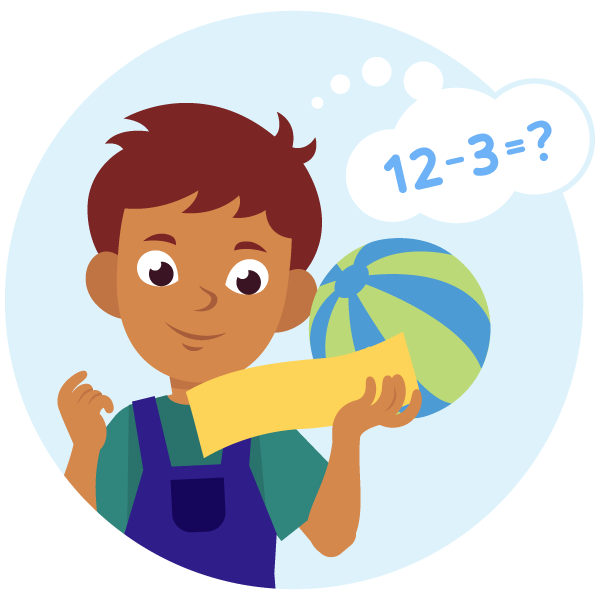16 Classroom Math Games for Learning and Fun
16 Classroom Math Games for Learning and Fun
“We’re going to play a math game,” you announce and the class cheers.
Classroom games are a great way to boost engagement and make learning fun. Most children love playing games in the classroom. However, it’s not always easy to target every skill with a game. Plus, some games get old after you’ve played them a few times.
We’re here to help with a great list of classroom math games for elementary age students. Are you ready to dive into some math fun? Check out the 16 math games below:
1st and 2nd Grade Math Games for the Classroom
Need some fun math teacher games for your lower elementary classroom? We have great whole class math games to enjoy:
1. Addition and Subtraction Bingo
To play this game, create bingo cards with the answers to simple addition and/or subtraction problems. Then, instead of reading out numbers, read out problems such as “7 + 3” or “5 – 2”. Students must then mark the correct answers to win the bingo game.
2. 101 Points
To play this game, divide the students into two teams (or play in many small groups). Each team takes turns rolling a dice. The goal of the game is to add up numbers to reach as close to 101 as possible, but without passing this number. Students can multiply the number on the dice by 10, or leave it as is. For example, they might roll a five and change it to 50. Then, they might roll a six and leave it as six, adding it to the 50 to get 56. Continue and see which team gets closer to 101 without passing it.
3. Action Addition and Subtraction
In this classroom game that can be played in small groups, use an action dice and two regular dice. You can make an action dice yourself with sides that say things like:
– Blinks
– Claps
– Jumps
– Twists
– Toe-wiggles
– Snaps
Then, have students roll the two regular dice and the action dice. Either have students add the two numbers together or subtract the smaller number from the bigger number. Then, they have to perform that number of actions they rolled on the action dice. For example if a student rolls a 2 and a 1, and they’re adding, they’d have to do 3 jumps, blinks, or claps, etc.
4. Math Twister
On a traditional twister game, add number labels such as 3, 4, 5, and 6. Then, instead of saying “right hand on blue,” read out equations such as “right hand on 6 – 3” or “left hand on 2 + 4”. Then, watch the fun and twisting begin!

5. Shape Scavenger Hunt
This quick math game is easy to plan and fun to carry out. Provide each student with a sheet of paper and a number of shapes listed or shown as pictures. Ask students to keep a tally of how many of each shape they can find in the classroom. Afterwards, you can have students graph their results.
6. Guess My Number
In this game, children practice numbers 0-100. Print out a sheet that has a grid of the numbers 0-100. To reuse, laminate them and provide students with white board markers. Then, have one student think of a number between 0 and 99. The students take turns guessing which number it is, crossing out the wrong numbers along the way. Finally, when the number is guessed, the winning guesser picks the new number.
3rd and 4th Grade Math Games for the Classroom
Classroom math games get a bit more complicated as students get older. Check out these games that work especially well in 3rd and 4th grade classrooms:
7. Multiplication and Division Bingo
To play this version of bingo, create bingo sheets with the answers to multiplication or division questions. Then, read out equations such as “6 x 9” or “81÷9”. Students must find the answer on their bingo sheet. The first person to get a whole row or column wins.
8. Sign My Sheet
This classroom math game involves doing math problems in an unorthodox way. Give each student a unique set of problems (can be about 10-15 or so). Then, instead of solving the problems on their own worksheets, students must solve other student’s problems. The person who solved the problem must sign their name. Each problem on a student’s worksheet must be signed and solved by a different student.
9. Math Revolution
Create “dance revolution” pads made out of poster board for each student. Each board should have the numbers 0-9. Then, name multiplication problems such as “3 x 9”. Students must then place their left foot on the tens and their right foot on the units. In this case, “2” and “7.” Speed up and see how fast they can dance!
Pro tip: For this one, have students work in socks! It may also be best to laminate the poster boards.
Any Grade Classroom Math Games
There are any of whole class math games that can be adapted for any grade. Here are a few of our favorites:

10. Stand Up or Sit Down
Keep students’ brains awake with this jumping game. When you read a problem and the answer is correct, students must stand up. If the answer is incorrect, they must stay sitting. Make it interesting by pitting the teacher against the class. When the whole class is correct, award them a point. When the class is wrong, award the teacher a point.
Other options can be:
– Stand up when the number is even
– Stand up when the number is a prime number
11. Around the World
Using flashcards, get students competing against each other on whatever skill you’re working on. Seat students in a circle. Have one student stand behind another. Show them the same flashcard. Whichever of the two gets the answer correct stands behind the next student. Students continue to see if they can make it all “around the world.”
12. Hot Potato
Tape math questions to a plastic ball using masking tape. Play hot potato, passing the ball around until the music stops. Whoever has the ball when the music stops must pick one of the math questions, peel it off the ball, and answer it.
13. Math Facts Race
Divide the class into two teams, each lined up. At the front of the room, provide two identical grids of multiplication or addition facts. The first person on each team must fill in one of the numbers on their grid (for example, where the 6 and 6 intersect, its 36 if multiplying). Then, they go to the end of the line and pass the marker up to the first person in line. Whichever team to finish their grid first, wins.
14. Stella Ella Ola to 100
Seat students in a circle. Play the hand slapping game “stella ella ola”. However, instead of counting to five or ten, count by 3s, 4s, 5s, etc. until you get to 100. If the person slaps the next person’s hand on 100 or the first number over 100, they’re out!
15. Jeopardy
Set up your own jeopardy board with categories and point values. Some categories could be: graphing, geometry, area and perimeter, addition, subtraction, multiplication, division, etc. Then, assign at least 3 questions of 3 different point values to each category. Split the class into two teams. Allow each team to pick the card they want. If they get the answer wrong, the other team has a chance to try. See which team earns the most points!
16. Jump on the Answer
On the playground, write out many different answers (repeat them several times) using sidewalk chalk. Then read out an equation such as “10 + 5” and have students run and stand on the correct answer. Remind students that more than one student can put their foot on an answer.
17. Home Made Board Game
In small groups, invite children to create their own board game. Demonstrate how to draw a snake “road” to follow and how to draw the squares. On each square, give them a math problem to place on the board. Then, provide pieces and dice and invite them to play. Students may also put some spaces that say “go back 2” or “lose a turn” to keep things interesting. Also, ask students to decorate the game with a theme.
18. Popsicle stick Poll
Conduct a class poll in which students answer a question such as “what is your favorite fruit?” or “homework is important, yes, or no.” Then, have students place a popsicle stick to vote for their answer in cups labeled with the answers. Once the poll is complete, ask students to graph the answer. Older students can show the percentage of how many students in the class voted for each answer.
